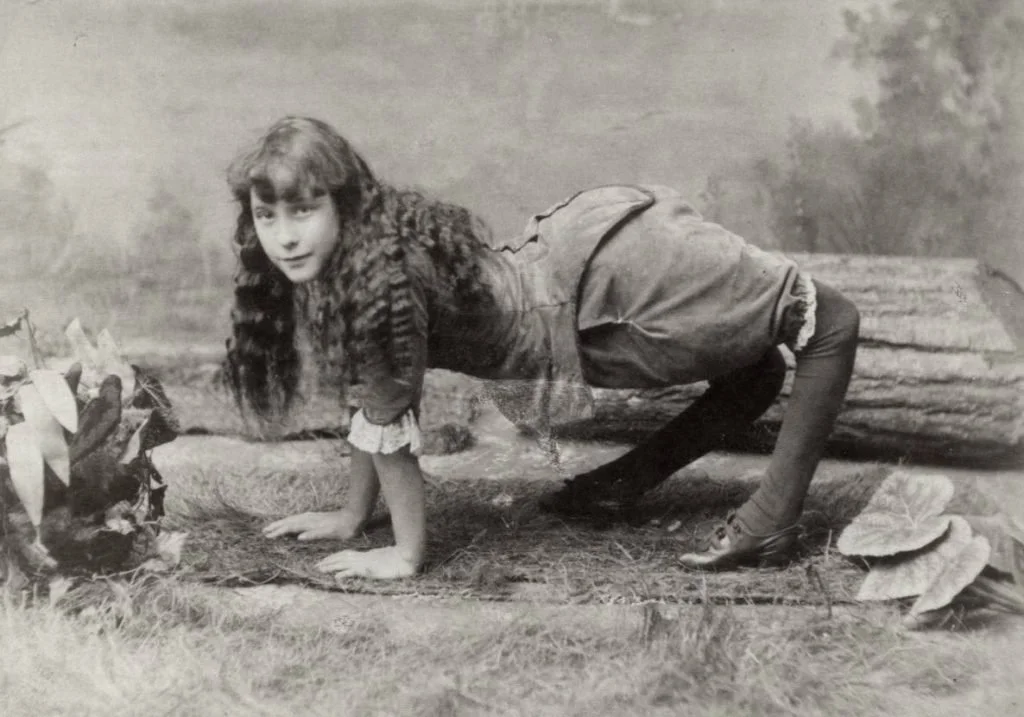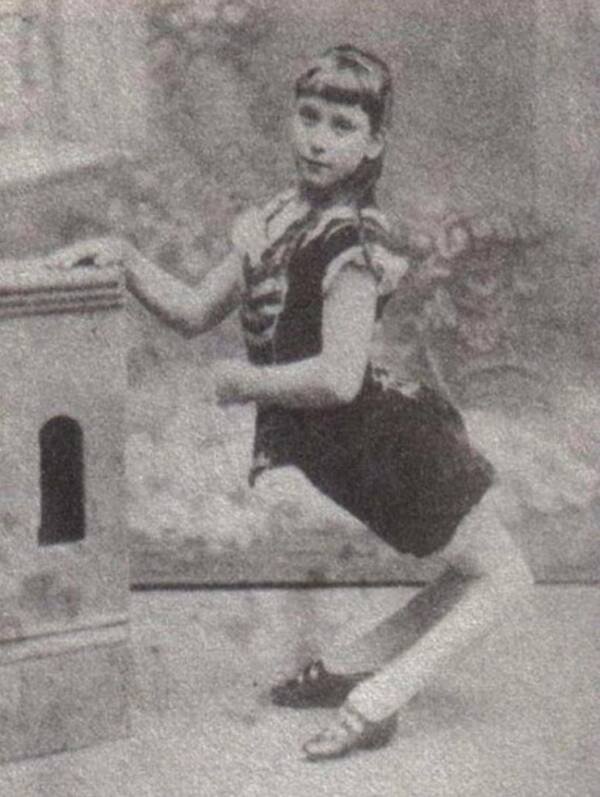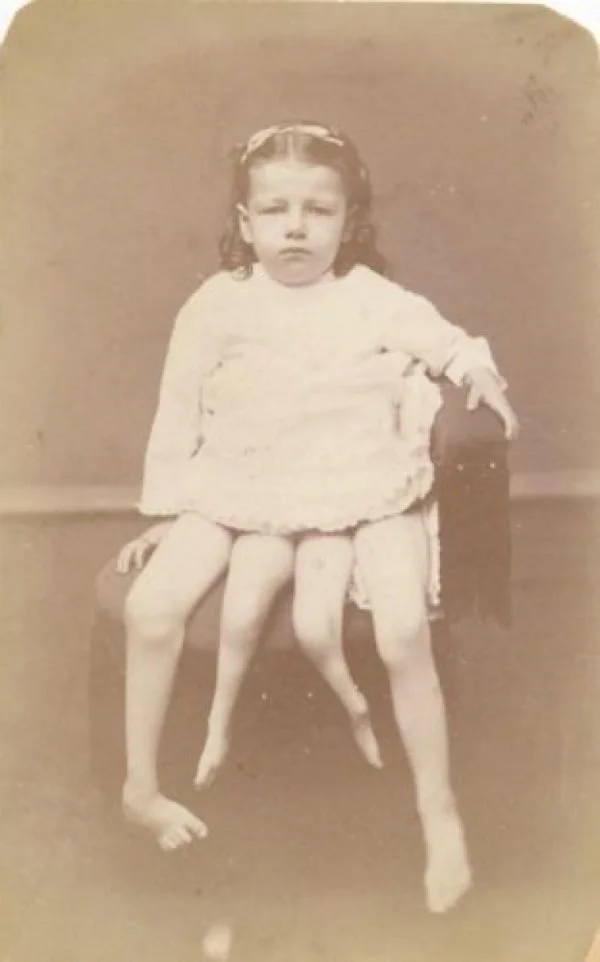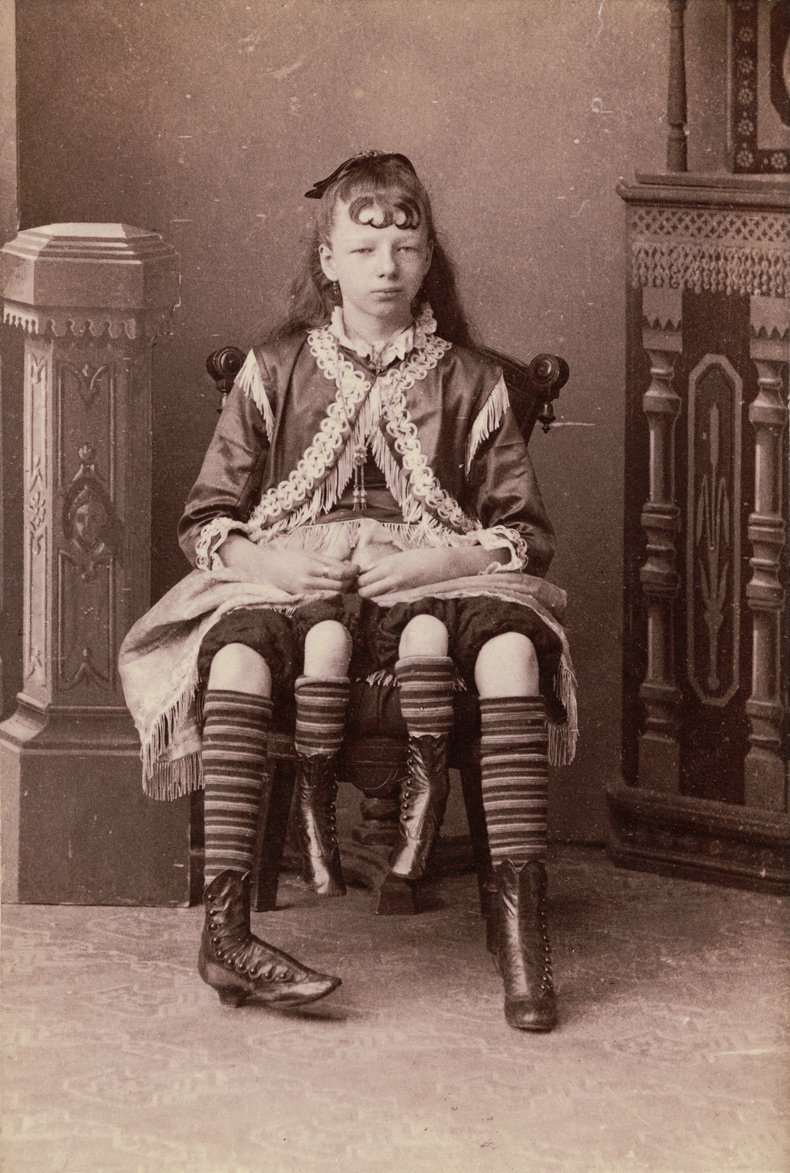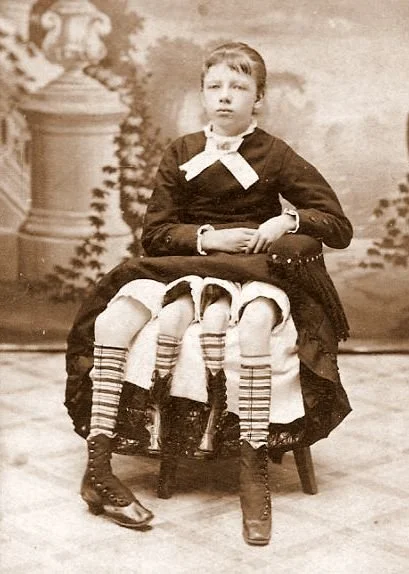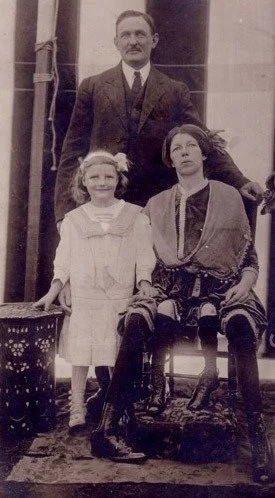Ella Harper & Myrtle Corbin - More Than a Curiosity
One challenge I have faced is that many stories, especially those of people who were exhibited in sideshows, just do not have that much information available. I still want to tell these stories, not to show off the so-called "freaks" and "oddities," but to demonstrate how life was like for anyone who was physically or mentally atypical. If you were born outside the norm in the 1800s and 1900s, it was extremely likely that at least some of your life would be spent making money (maybe) as an exhibit. I have decided to share some of these stories in combined posts called "More Than a Curiosity." I chose this title because, even today, many of these people are shown in listicles or videos as the subjects of shock, disgust, or "wtf?" They deserve better than that. Today's subjects, Ella Harper and Myrtle Corbin, lived at around the same time and were both born in Tennessee. Interestingly, both spent their teenage years successfully performing before retiring to quiet lives with their families (though Myrtle did perform during her 40s). They married, had children, and made their homes. They experienced all of the joys and sorrows of simply being human.
Ella Harper & Myrtle Corbin
Ella Harper
Ella Evans Harper was born on January 5, 1870 in Hendersonville, Sumner County, Tennessee. She was the twin of a boy named Everett, who died a few months later on April 4. They were the children of William and Minerva Ann Childress Jackson Harper, Tennessee farmers who also raised livestock.
Minerva had already lived a hard life: her biological parents, John and Elmira Childress, died when their home burned down when she was a child (sometime before the age of seven). She was then adopted by William and Nancy Ann (née Vanderville) Jackson. Her sister, Susan Margaret, was adopted by a family who then moved to Missouri. Ella's father, William Harper, was born to Virginian natives, his father being a farmer and stone-mason. The two had wed in 1863 and had their first child two years later. He almost definitely served during the American Civil War and most likely for the Confederate Army, though I could not find any records either way. He was a Democrat, member of the Masonic fraternity, and part of the Methodist Episcopal Church, South.
Ella's parents, William & Minerva Harper, undated
Together they had five surviving children: Sallie Irene, Willie Johnelle, Ella, Jessie Lee, and Earl Phelan. Family lore said that Earl was a foster brother, though may have still related to the Harpers somehow. He was apparently found on their porch in a basket and the descendants still have that basket. DNA testing of a descendant of Earl's in 2015 confirmed that Earl was related to Ella's father, William. This descendant, Jeanette Daeschner, theorized that William had an affair and this woman left Earl on his porch for him to raise.
It was immediately apparent that Ella was not physically typical. She had a rare orthopedic condition called congenital genu recurvatum (literally "curved knee"), which caused her knees to bend backwards. It can also be called a "hyperextension deformity of the knee." Because of this, it was easier for her to walk on all fours. In the 1880 census, which contained a Health category, she was checked under the column of "Maimed, Crippled, Bedridden, or otherwise disabled." Her disability was listed as "deformed." Also in this census, she and her family are listed as living with her paternal grandparents near Gallatin, Tennessee.
Ella Harper, 1886
In 1882, at the age of twelve, Ella began traveling with circuses as a sideshow exhibit. She joined W.H. Harris's Nickel Plate Circus as the star in 1886. Ella performed under the nickname "Camel Girl," due to how she walked, and was even advertised in newspapers as "part camel." She was put onstage with an actual camel while paying spectators marveled at their similarities. She was called "the most wonderful freak of nature since the creation of the world." A May 1886 article did call her a fraud and said that she was "actually just a pleasant-faced young girl with backwards knees." Ella received a salary of $200 a week ($6300 in 2023), a phenomenal sum. She mostly performed in the St. Louis and New Orleans areas, but did travel through a number of other states too. A New York photojournalist even did a photo session with her in 1886.
Ella Harper, 1882
At performances, pitch cards were handed out: "I am called the camel girl because my knees turn backward. I can walk best on my hands and feet as you see me in the picture. I have traveled considerably in the show business for the past four years and now, this is 1886 and I intend to quit the show business and go to school and fit myself for another occupation." She did indeed retire from performing that year.
Advertisement for Ella
Ella decided to move back home with her family. Her father died on August 26, 1890, at only 46, in a house fire. Five years later, Ella's older sister Willie died from tuberculosis at the age of 27, leaving behind a husband and 15-month-old daughter, Lillian. In the 1900 census, Ella is listed as living with her widowed mother and Lillian in Sumner County. Soon after this, Lillian's father remarried, taking his daughter with him.
Ella wed Robert L. Savely on June 28, 1905; she was 35 and he 37. They had two daughters: Mabel Evans (April 27, 1906, biological, died on October 1 of that year) and Jewel (1918, adopted from a local orphanage, died at only a few months old). Jewel's cause of death was listed as "status lymphaticus," which was believed to be the cause of Sudden Infant Death Syndrome (SIDS) at this time. One source claimed that Jewel died just 18 days after being adopted.
Ella Harper, undated
In the 1910 census, Ella and Robert are recorded as married and living together in Nashville with Ella's mother, Minerva. Robert was listed as a public school teacher and Ella as having borne one child but none living. In 1916, Ella joined the Seventh-Day Adventist Church. By the 1920 census, still at their home on 1012 Joseph Avenue in Nashville, Robert was noted as being a bookkeeper for a photo supply company. Minerva also no longer lived with them: she had moved into the Home for Masonic Widows and Orphans in Nashville. She herself passed away in 1924, at the age of 80.
Ella died from colon cancer on December 19, 1921, just shy of her 52nd birthday and three years after losing their adopted baby, Jewel. Her grave is at the Spring Hill Cemetery in Nashville, Tennessee. She was buried in the family plot, which currently holds Ella and many other family members, including both of her daughters, her parents, her three sisters, two siblings-in-law, and a nephew. Ella's husband, Robert, remarried three years later to Elizabeth Gabard, seventeen years his junior, and himself died in 1932. He is buried in the same cemetery as both of his wives.
Ella's gravestone
Myrtle Corbin
Josephine Myrtle (called "Myrtle") Corbin was born in Lincoln County, Tennessee on May 12, 1868. Her parents were William H. and Nancy (née Sullins) Corbin, ages 25 and 34 respectively. Nancy also had a child, Laura Ann, from a previous marriage and the couple eventually had five children - Mary Frances, Myrtle, Willie Ann, James Henry, and Merida - together. (Some reports say they had eight total children, but this varied.) Physicians examining the baby after her birth were compelled to report that William and Nancy were not "blood kin," though they looked so similar ("both having auburn hair, blue eyes and very fair complexion"). This was a case of doctors trying to find a reason (inbreeding) for Myrtle's unique body.
Though there was "nothing peculiar about the labour or delivery," it was immediately apparent that Myrtle was physically different. She had two separate pelvises side by side from the waist down, a condition known as a "dipygus deformity." Doctors at the time also called her "dipygus dibrachius tetrapus" and "a female, belonging to the monocephalic, ileadelphic class of monsters by fusion." One professor simply called her "this infant monstrosity." Her condition was also called "'posterior dichotomy,' subvariety schizorachis." This is now called Caudal Duplication Syndrome and is extremely rare, especially with such a complete duplication as with Myrtle. Her body axis split as it grew in the womb, giving her the appearance of a conjoined twin that never fully developed. Each of her smaller inner legs was paired with one of her outer legs. These inner legs were too weak to walk on and only had three toes on each foot, though Myrtle said she could move these limbs. Doctors theorized that, if Myrtle had been born breeched (she was briefly in that position), she and her mother would have both died in labor.
Myrtle as a child, undated
Myrtle as a child, undated
The baby was very strong, however, reaching 10 pounds three weeks after birth. A journal published later that year noted that Myrtle "nurses healthily" and was "thriving well." She did have some difficulty walking, as one of her outer legs had a club foot. More than a few articles pointed out the irony that she had four legs but only one worked typically. Her anatomy fascinated the doctor. Because Myrtle urinated and defecated through both external openings, he also theorized that she could become pregnant "on both sides." Later, when she hit puberty, she would indeed menstruate from each uterus.
William was a Confederate veteran who had endured severe wounds in his right arm and left hand. He needed money for his growing family and began showing Myrtle to curious neighbors when she was just a month old, charging a dime ($2.00 in 2023) per visit. He and Nancy defended their decision, claiming the money would be used to educate their daughter and help her succeed in life.
Her father placed ads in newspapers and eventually attracted national publicity. Spectators looked on with curiosity, revulsion, and fascination. When she appeared onstage, all they could initially see were large hips and a clubbed right foot. She would lift her gown to show her additional legs, dressed in matching socks and shoes to the ones her outer legs wore, and the crowd would gasp.
Myrtle as a teenager, undated
Myrtle as a teenager, undated
The family moved to Alabama at some point when Myrtle was a child. At 13, in 1881, she officially entered the sideshow business as "The Four-Legged Girl." One pamphlet advertised her as "gentle of disposition as the summer sunshine and happy as the day is long." The following year, she caught P.T. Barnum's attention and was signed up for Barnum & London Tours, followed by touring with the Ringling Brothers Circus and on Coney Island. She became an extremely popular exhibition, causing other showmen to fake similar acts. Myrtle spent the next four years performing before retiring at age 18. She had earned as much as $450 per week ($14,000 in 2023).
In 1885, Myrtle's sister Willie Ann married Hiram Locke Bicknell. His brother, James Clinton Bicknell (called "Clinton") proposed to Myrtle shortly after. The two wed in June 1886 when they were both about 18 years old. Because he insisted that she never return to show business, it seems that he did marry for love instead of money. Several sources referred to him as a doctor, though I could not verify this.
About a year later, she became pregnant for the first time and was very sick. Because of pain in her left side, fever, headache, and decreased appetite, the family physician, Dr. Lewis Whaley of Blountsville, Alabama, was sent for. He wrote that "vomiting and amenorrhoea had persisted for two months" in an article for the Atlanta Medical and Surgical Journal. He referred to her as "Mrs. B." and his published reports led to a renewed interest in Myrtle. Whaley discovered that both her external and internal sexual organs were duplicated and that only her left uterus was pregnant. He reported that Myrtle said, "If it had been in my right side I would come nearer believing you are correct," which he interpreted to mean that her husband preferred intercourse in the right side. Myrtle became critically ill with this pregnancy and Whaley decided to perform an abortion after caring for her for two months. He did so when she was about three or four months pregnant and she made a full recovery.
Numbers vary, but it appears that Myrtle gave birth to seven more children, all carried to term successfully. Four lived to adulthood - Nancy Estelle, Francis Clinton (or Clinton Francis), Ruby Eugenia, and Lillian Josephine - and three others died in infancy. It was rumored that half were born from one uterus and half from the other, which was technically possible. More medical articles were released about her as an adult, one noting that: "The lady, Mrs. B... the Myrtle Corbin of days gone by, [is] attractive in face, physically well, and able to attend to all her household duties." Another described her as "very intelligent" and "a refined woman, of some musical taste."
Myrtle as a teenager, undated
In an 1889 British Medical Journal article, Dr. Whaley was quoted as saying, "She is about five feet high, has fair skin, blue eyes, and curly hair, and is very intelligent. A stranger, to see her in company, would only think her unusually broad across her hips, and with the carriage usual to one with clubbed foot. I have known Mrs. B. since she was a tiny child, as the 'four-legged girl,' but never realised the perfect dual development of both external and internal genital organs until she became my patient in [a] case of pregnancy."
Myrtle and her husband moved from Alabama to Texas in the early 1890s. They settled in Cleburne, living their lives apparently happily as farmers. In the early 1900s, it does appear that their financial situation declined, as Myrtle came out of retirement briefly. At the age of 41, in 1909, she appeared at Huber's Museum (a dime museum) in New York. She continued performing until 1915, appearing at the Dreamland Circus Sideshow on Coney Island and at Riverview Park in Chicago. She retired once more and did not return to the sideshows after this.
Myrtle, her husband Clinton, & their daughter Lillian, 1915
In 1928, Myrtle developed a skin infection on her right leg. She went to a doctor but nothing could be done for her. Antibiotics did not exist at this time and she died less than a week later from "erysipilas," a streptococcal skin infection, on May 6. She was 59 years old. Several medical practitioners and private collectors offered financial compensation for her corpse, which her family refused. They covered her casket in concrete and kept watch until it was fully cured to prevent grave robbers.
Myrtle's gravestone
Most sincerely,
ChristinaFurther Media of Interest
"Visiting the Camel Girl" from Mobile Instinct on YouTube (2021)
"The Shocking True Story of the 'Four-Legged Girl' | Josephine Myrtle Corbin" from Forgotten Lives on YouTube (2022)
The episode "Myrtle Corbin: The Four-Legged Girl" from the Circus Stories podcast (2021)
Four-Legged Girl: Poems by Diane Seuss (Finalist for the Pulitzer Prize in Poetry, 2016)
Works Consulted (Ella Harper)
Dimri, B. (2022, September 20). Who Was The Camel Girl? Ella Harper, The Tragic Teen Sensation. Historic Mysteries. Retrieved January 26, 2023, from https://www.historicmysteries.com/camel-girl/
Harris, K. (2022, September 2). The Camel Girl: A 19th-Century Oddity Who Escaped The Circus. History Daily. https://historydaily.org/ella-harper-camel-girl
Kageyama, B. (2020, October 19). The Girl Newspapers Called “Part-Camel-Part-Human”: The Life of Ella Harper, AKA the “Camel Girl.” Medium. https://medium.com/lessons-from-history/the-girl-newspapers-called-part-camel-part-human-6dc93993cf1c
Lu, S. (2022, October 23). Ella Harper – the untold story of the camel girl. Mysteries Unsolved. Retrieved January 26, 2023, from https://mysteriesrunsolved.com/2020/05/ella-harper-the-camel-girl.html
Margaritoff, M. (2021, September 2). The Heartbreaking Story of Ella Harper, “The Camel Girl” Put on Display in 19th-Century Sideshows (E. Hawkins, Ed.). All That’s Interesting. https://allthatsinteresting.com/ella-harper
Middleton, P. (2019, January 23). Ella Harper – The Camel Girl Story. Anomalien.com. Retrieved January 26, 2023, from https://anomalien.com/ella-harper-the-camel-girl-story/
Mullin, R. (2015, April 19). Ella Evans Harper Savely. Find a Grave. Retrieved January 26, 2023, from https://nl.findagrave.com/memorial/145235600/ella-evans-savely
RayM. (2015, April 18). Finding Ella (my search for The Camel Girl). Ella Harper. Retrieved January 26, 2023, from https://ellaharper.wordpress.com/2015/04/18/finding-ella-my-search-for-the-camel-girl/
Verma, A. (2022, June 22). Ella Harper Dubbed The Camel Girl - The Heartbreaking Story Of A Unique Lady. Thoughtnova. Retrieved January 26, 2023, from https://thoughtnova.com/ella-harper-the-camel-girl
Weekly Recess. (2022, June 1). The Heartbreaking Story Of Ella Harper, The ‘Camel Girl.’ Retrieved January 26, 2023, from https://weeklyrecess.com/article/the-heartbreaking-story-of-ella-harper-the-camel-girl
Works Consulted (Myrtle Corbin)
Bizzarrobazar. (2018, June 19). Myrtle The Four-Legged Girl. Bizzarro Bazar. Retrieved January 26, 2023, from https://www.bizzarrobazar.com/en/2018/06/19/myrtle-la-ragazza-con-4-gambe/
Emma. (2022, August 6). Myrtle Corbin: Four-legged woman and “freak show” star. Sinister Isles. Retrieved January 26, 2023, from https://www.sinisterisles.com/post/myrtle-corbin-four-legged-woman-freak-show
Esh. (2021, March 29). Incredible Lady Who Had Two Private Parts, Four Legs & Eight Children. Medium. Retrieved January 26, 2023, from https://medium.com/lessons-from-history/incredible-lady-who-had-two-private-parts-four-legs-eight-children-38680dd38bde
Evon, D. (2021, June 29). Is This Josephine Myrtle Corbin, “The 4-Legged Girl”? Snopes. Retrieved January 26, 2023, from https://www.snopes.com/fact-check/josephine-myrtle-corbin-4-legged-girl/
phocks. (2008, November 24). Josephine Myrtle “Four legged lady” Corbin Bicknell. Find a Grave. Retrieved January 26, 2023, from https://nl.findagrave.com/memorial/31675682/josephine-myrtle-bicknell
Robinson, J. (n.d.). Josephine Myrtle Corbin. Sideshow World. Retrieved January 26, 2023, from http://www.sideshowworld.com/76-Blow/Myrtle/Corbin-1.html
Serena, K. (2018, May 17). The Story Of Myrtle Corbin, P.T. Barnum’s “Four-Legged Girl From Texas.” All That’s Interesting. Retrieved January 26, 2023, from https://allthatsinteresting.com/myrtle-corbin
Tabler, D. (2019, May 6). She had one husband, five children, and four legs. Appalachian History. Retrieved January 26, 2023, from https://www.appalachianhistory.net/2019/05/she-had-one-husband-four-children-and-four-legs.html
Ward, M. (2021, October 21). The four-legged woman was a real person, not some ghoul or monster. The Record. Retrieved January 26, 2023, from https://www.therecord.com/local-waterloo/opinion/2021/10/21/the-four-legged-woman-was-a-real-person-not-some-ghoul-or-monster.html
Last Updated: 25 Sept. 2023


